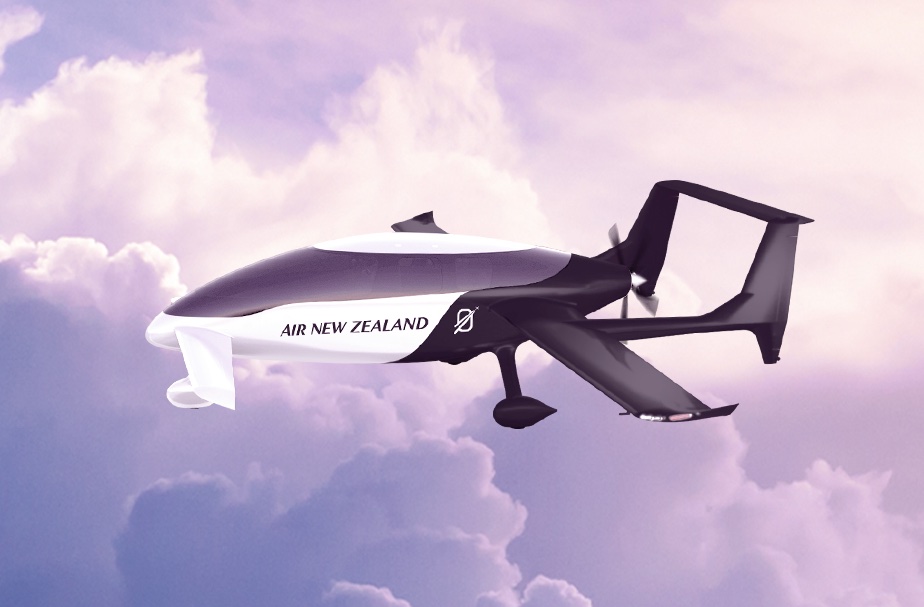
Voltero in the final in New Zealand

Voltaero Cassio in the colors of AIr New Zealand. International recognition of the French hybrid-electric aircraft. © Air New Zealand
There were 30 zero-emission aircraft project leaders on the starting line. Air New Zealand has selected 4 French Voltaero Cassio hybrid electric aircraft that are part of the last box.
Launched just a year ago in December 2021 by Air New Zealand, the Mission Next Gen Aircraft program aims to accelerate the development of zero-emission aircraft technology and the infrastructure needed to make it a reality for commercial aviation in New Zealand. Initially, it was a call for projects, to which about thirty startups responded. Air New Zealand has just revealed the names of the four finalists.
These are the American Beta Technologies with its eVTOL Alia-250c, the British Cranfield Aerospace and its hydrogen solution, the Israeli Eviation with its electric passenger Alice and finally the French Voltaero with its hybrid electric Cassio family.
“We know these goals are ambitious, but ambition is exactly what we need to make this new technology a reality.”
Greg Foran, Managing Director, Air New Zealand
Jean Petit, CEO and Head of Technology Development at Voltaero, sees this selection by Air New Zealand as an affirmation of ” Practical and realistic approach The problem of carbon removal from aviation. :” Instead of promises, today we can meet Air New Zealand’s requirements to demonstrate the next generation of sustainable aircraft.”
with his program Next Generation Aircraft mission The New Zealand company also adopted Practical and realistic approach Before committing to a specific project leader, as airlines generally do, it started by evaluating each other’s research, and the progress of those projects. And so she evaluated 30 projects to keep for the end, the four that seemed to her the most promising, but also the most advanced in the way At this point, you plan to sign letters of intent by the end of the year with the partners you will work with.
” The next three years will be devoted to supporting the construction, testing and certification of aircraft and associated infrastructure. By 2026, we want the first zero-emission aircraft, whether it’s a freighter or a passenger plane, to be flying in New Zealand. says Greg Foran, managing director of Air New Zealand. The company’s goal is to begin replacing its domestic fleet of Q300 turboprops with more sustainable aircraft,” he said. Maybe green hydrogen or battery hybrid systems As of 2030, she says.
“The technology is coming, it just needs to be developed to a scale that we can deploy on our network. This is a difficult problem to solve, but we are already working on it.”
Greg Foran, Managing Director, Air New Zealand
Air New Zealand mainly operates short-haul routes across the country, and New Zealand is built largely on renewable electricity generation: “ It is an ideal scene for adopting zero-emission aircraft. says Greg Foran.
The first version launched by Voltaero is the Cassio 330, which has five seats and is powered by a 330 kW hybrid electric propulsion system. ” It is due to enter service at the end of 2024, well ahead of Air New Zealand’s target to purchase sustainable next-generation aircraft for delivery from 2026. Jean Petit says
The six-seat Cassio 480 from VoltAero will have a hybrid-electric powertrain of 480 kW, while the 12-seater Cassio 600 will have a hybrid-electric power of 600 kW. Logically, it is these models, particularly the 12-seat passenger, that should be of particular interest to Air New Zealand. Far from one model or another, the technological option of the hybrid electric formula has been chosen. It has been approved by a major airline. This is the best thing that could happen to Jean Petit, at the end of 2022, which, in the end, will be decisive for Voltero.
Jill Roy

“Reader. Travel maven. Student. Passionate tv junkie. Internet ninja. Twitter advocate. Web nerd. Bacon buff.”
